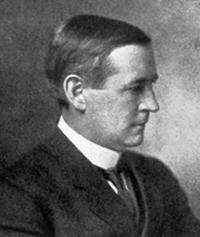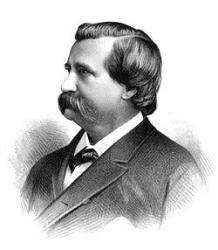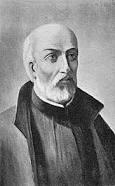Planning worship?
Check out our sister site, ZeteoSearch.org,
for 20+ additional resources related to your search.
- |
User Links
Person Results
Jesse Edgar Middleton

1872 - 1960 Meter: 8.6.8.6.8.6 with refrain Translator of "Huron Carol" in Songs for Life Middleton, Jesse Edgar. (Wellington County, Ontario, November 3, 1872--May 27, 1960, Toronto, Ont.). United Church. Although he trained as a teacher, he turned to journalism in 1895. After learning his new trade, he became the Montreal Herald's correspondent in Quebec, and was there when Ernest Myrand brough out Noels anciens de la Nouvelle-France (1899), containing a French version of the carol which Father Brebeuf, S.J., had written in 1641 for the Huron, whose descendents had handed it on by oral tradition.
He then came to Toronto as a special writer for The Mail and Empire, and from 1942 onward, for Saturday Night as well; meanwhile, he served Centennial Church as choirmaster for about 40 years. With all this, he managed to produce several books on the history of Toronto and Ontario; though not an academic, neither was he a dilettante, and the leading scholars of the province were glad to work with him. His pamphlet on The First Canadian Carol came out in 1927, simultaneously with the first volume of his History of Ontario, in which Brebeuf's mission forms the earliest fully-documented episode; hence we may believe that Middleton knew what he was about in preparing "'Twas in the moon of winter-time."
--Hugh D. McKellar, DNAH Archives
===============================
Jesse Edgar Middleton, 1872-196
Born: November 3, 1872, Pilkington, Ontario, Canada.
Died: May 27, 1960, Toronto, Canada.
Buried: Fort Macleod, Alberta, Canada.
Son of a Methodist minister, Middleton attended Dutton High School and the Strathroy Collegiate Institute, then taught school for three years. He then worked for three years as a proofreader for a publisher in Cleveland, Ohio, and later became music critic for the Mail and Empire. In 1904, he joined The News. He also led the choir at the Centennial Methodist Church, and sang in the Mendelssohn Choir.
Sources: Stulken, p. 175
Translations "’Twas in the Moon of Wintertime"
--www.hymntime.com/tch
Jesse Edgar Middleton
John Stainer

1840 - 1901 Person Name: John Stainer, 1840-1901 Meter: 8.6.8.6.8.6 with refrain Harmonizer of "GOD REST YOU MERRY" in Gather Comprehensive
John Stainer
Christopher M. Idle
b. 1938 Meter: 8.6.8.6.8.6 with refrain Author of "For Ever, Lord, I'll Sing Your Love" in Scripture Song Database Christopher Martin Idle (b. Bromley, Kent, England, 1938) was educated at Elthan College, St. Peter's College, Oxford, and Clifton Theological College in Bristol, and was ordained in the Church of England. He served churches in Barrow-in-Furness, Cumbria; London; and Oakley, Suffolk; and recently returned to London, where he is involved in various hymnal projects. A prolific author of articles on the Christian's public responsibilities, Idle has also published The Lion Book of Favorite Hymns (1980) and at least one hundred of his own hymns and biblical paraphrases. Some of his texts first appeared in hymnals published by the Jubilate Group, with which he is associated. He was also editor of Anglican Praise (1987). In 1998 Hope Publishing released Light Upon the River, a collection of 279 of his psalm and hymn texts, along with suggested tunes, scripture references, and commentary.
Bert Polman
Christopher M. Idle
Adam Geibel

1855 - 1933 Meter: 8.6.8.6.8.6 with refrain Composer of "[If we are foll'wing Christ each day]" in Timeless Truths Born: September 15, 1855, Neuenheim, Germany.
Died: August 3, 1933, Philadelphia, Pennsylvania.
Though blinded by an eye infection at age eight, Geibel was a successful composer, conductor, and organist. Emigrating from Germany probably around 1864, he studied at the Philadelphia Institute for the Blind, and wrote a number of Gospel songs, anthems, cantatas, etc. He founded the Adam Geibel Music Company, later evolved into the Hall-Mack Company, and later merged to become the Rodeheaver Hall-Mack Company. He was well known for secular songs like "Kentucky Babe" and "Sleep, Sleep, Sleep." In 1885, Geibel organized the J. B. Stetson Mission. He conducted the Stetson Chorus of Philadelphia, and from 1884-1901, was a music instructor at the Pennsylvania Institution for the Instruction of the Blind. His works include:
Evening Bells, 1874
Saving Grace, with Alonzo Stone (Philadelphia, Pennsylvania: Stone & Bechter, Publishers, 1898)
Consecrated Hymns, (Philadelphia, Pennsylvania: Geibel & Lehman, 1902)
Uplifted Voices, co-editor with R. Frank Lehman (Philadelphia, Pennsylvania: Geibel & Lehman, 1901)
World-Wide Hosannas, with R. Frank Lehman (Philadelphia, Pennsylvania: Geibel & Lehman, 1904)
Hymns of the Kingdom, co-editor with R. Frank Lehman et al. (Philadelphia, Pennsylvania: Geibel & Lehman, 1905)
--www.hymntime.com/tch/
Adam Geibel
Lida Shivers Leech
1873 - 1962 Person Name: Lydia S. Leech Meter: 8.6.8.6.8.6 with refrain Author of "Win One Every Day" in Timeless Truths Born: July 12, 1873, Mayville, New Jersey.
Died: March 4, 1962, Long Beach, California.
Leech spent her childhood in Cape May Court House, New Jersey, and attended Columbia University and Temple University. She played the organ at Bethany Methodist Church in Camden, New Jersey, served as accompanist at evangelical services, and wrote some 500 hymn tunes in her lifetime.
Sources--
Emurian, pp. 112-3
Reynolds, p. 336
Lyrics--
God’s Way Is Best
I Have Redeemed Thee
I’ll Go Anywhere
No Fault in Him
Some Day He’ll Make It Plain
Thine for Service
Trust Me, Try Me, Prove Me © 1928
When the Veil is Lifted
--www.hymntime.com/tch
Lida Shivers Leech
Adrian Vernon Fish
b. 1956 Meter: 8.6.8.6.8.6 with refrain Arranger of "GOD REST YOU MERRY" in Complete Anglican Hymns Old and New
Adrian Vernon Fish
Jean de Brébeuf

1593 - 1649 Person Name: Jean de Brebeuf Meter: 8.6.8.6.8.6 with refrain Author (Huron) of "Huron Carol" in Songs for Life Jean de Brébeuf, Jesuit missionary, born at Condé-sur-Vire in Normandy, 25 March, 1593; died in Canada, near Georgian Bay, 16 March, 1649. His desire was to become a lay brother, but he finally entered the Society of Jesus as a scholastic, 8 November, 1617. According to Ragueneau it was 5 October. Though of unusual physical strength, his health gave way completely when he was twenty-eight, which interfered with his studies and permitted only what was strictly necessary, so that he never acquired any extensive theological knowledge. On 19 June, 1625, he arrived in Quebec, with the Recollect, Joseph de la Roche d' Aillon, and in spite of the threat which the Calvinist captain of the ship made to carry him back to France, he remained in the colony. He overcame the dislike of the colonists for Jesuits and secured a site for a residence on the St. Charles, the exact location of a former landing of Jacques Cartier. He immediately took up his abode in the Indian wigwams, and has left us an account of his five months' experience there in the dead of winter. In the spring he set out with the Indians on a journey to Lake Huron in a canoe, during the course of which his life was in constant danger. With him was Father de Noüe, and they established their first mission near Georgian Bay, at Ihonatiria, but after a short time his companion was recalled, and he was left alone.
Brébeuf met with no success. He was summoned to Quebec because of the danger of extinction to which the entire colony was then exposed, and arrived there after an absence of two years, 17 July, 1628. On 19 July, 1629, Champlain surrendered to the English, and the missionaries returned to France. Four years afterwards the colony was restored to France, and on 23 March, 1633, Brébeuf again set out for Canada. While in France he had pronounced his solemn vows as spiritual coadjutor. As soon as he arrived, viz., May, 1633, he attempted to return to Lake Huron. The Indians refused to take him, but during the following year he succeeded in reaching his old mission along with Father Daniel. It meant a journey of thirty days and constant danger of death. The next sixteen years of uninterrupted labours among these savages were a continual series of privations and sufferings which he used to say were only roses in comparison with what the end was to be. The details may be found in the "Jesuit Relations".
In 1640 he set out with Father Chaumonot to evangelize the Neutres, a tribe that lived north of Lake Erie, but after a winter of incredible hardship the missionaries returned unsuccessful. In 1642 he was sent down to Quebec, where he was given the care of the Indians in the Reservation at Sillery. About the time the war was at its height between the Hurons and the Iroquois, Jogues and Bressani had been captured in an effort to reach the Huron country, and Brébeuf was appointed to make a third attempt. He succeeded. With him on this journey were Chabanel and Garreau, both of whom were afterwards murdered. They reached St. Mary's on the Wye, which was the central station of the Huron Mission. By 1647 the Iroquois had made peace with the French, but kept up their war with the Hurons, and in 1648 fresh disasters befell the work of the missionaries — their establishments were burned and the missionaries slaughtered. On 16 March, 1649, the enemy attacked St. Louis and seized Brébeuf and Lallemant, who could have escaped but rejected the offer made to them and remained with their flock. The two priests were dragged to St. Ignace, which the Iroquois had already captured.
On entering the village, they were met with a shower of stones, cruelly beaten with clubs, and then tied to posts to be burned to death. Brébeuf is said to have kissed the stake to which he was bound. The fire was lighted under them, and their bodies slashed with knives. Brébeuf had scalding water poured on his head in mockery of baptism, a collar of red-hot tomahawk-heads placed around his neck, a red-hot iron thrust down his throat, and when he expired his heart was cut out and eaten. Through all the torture he never uttered a groan. The Iroquois withdrew when they had finished their work. The remains of the victims were gathered up subsequently, and the head of Brébeuf is still kept as a relic at the Hôtel-Dieu, Quebec.
His memory is cherished in Canada more than that of all the other early missionaries. Although their names appear with his in letters of gold on the grand staircase of the public buildings, there is a vacant niche on the façade, with his name under it, awaiting his statue. His heroic virtues, manifested in such a remarkable degree at every stage of his missionary career, his almost incomprehensible endurance of privations and suffering, and the conviction that the reason of his death was not his association with the Hurons, but hatred of Christianity, has set on foot a movement for his canonization as a saint and martyr. An ecclesiastical court sat in 1904 for an entire year to examine his life and virtues and the cause of his death, and the result of the inquiry was forwarded to Rome. [He was canonized in 1930. --Ed.]
--www.newadvent.org/cathen/02751b.htm
Jean de Brébeuf


 My Starred Hymns
My Starred Hymns


